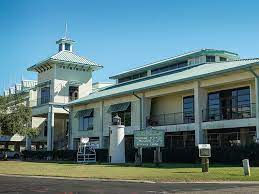Explore Madisonville on the Tchefuncte River
- maryrickard
- Jul 8, 2023
- 3 min read
Updated: Aug 5, 2023

It has been insanely hot in New Orleans (and practically everywhere else, apparently) so I was thinking about places that sounded cool - cool in the sense of being interesting and cool like water. I remembered that I’ve wanted to visit the Maritime Museum Louisiana, which is located in Madisonville, across Lake Pontchartrain over the Causeway on the Tchefuncte (cha-funk-tah) River.

The Maritime Museum did not disappoint. I expected to learn about watercraft, of course, and waterfowl, but hadn’t realized the tiny city founded in 1800 and named for President James Madison, had played such large roles in the War of 1812, Civil War, World War I and World War II. How ‘bout them apples?
Most New Orleanians are familiar with the Battle of New Orleans, fought in 1815 and led by Gen. Andrew Jackson on Chalmette Battlefield, but there were also naval battles between the British and the Americans. Hoping to control river traffic, the British had blockaded the mouth of the Mississippi River, challenging the Confederates to obtain supplies (except from pirates).
During the Civil War, tiny Madisonville, still under the Confederacy, was busily building ships from native, 1,000-year-old Cypress trees. And not only wooden ships, but an experimental, iron submarine, named the SS Pioneer, powered by men, manually rotating underwater propellers. (At that time, a submarine could only stay underwater as long as there was oxygen for the crew.) We all know the Union won, although the H.L. Hunley submarine was designed later in the war to dive under its target while towing a torpedo on a 200-foot tether. After a couple of tragic mishaps, Hunley did manage to sink the USS Houstatonic in Charleston Harbor. You can see a replica of the early submarine at the Maritime Museum.
Following the Louisiana Purchase in 1803, many Germans emigrated to the new territory, including Fritz Jahncke who left Hamburg at 19 to find work as a mason. Acadians from Nova Scotia, were the first Europeans to settle the area, farming and fishing. Foreseeing the need for real streets (!), Jahncke opened his own paving business in 1875 and then bought Baham Shipyard on the Tchefuncte. Luggers - small, round-hulled wooden boats - were used to transport goods, including produce, across the lake to New Orleans.
Jahncke got contracts during WWI to build warships SS Bayou Teche and SS Balabac. It seems the United States had depleted its steel so wooden ships were employed. At its height, Jahncke had amassed 2,200 workers.
During WWII, Liberty Ships transported cargo, food, supplies and people to the warfronts. Mass-produced on an unprecedented sale, these commercial merchants vessels had simple, low-cost construction often executed by female workers. Oyster boats were also adapted to war use. Models are exhibited at the museum.
Without a doubt, steamboats revolutionized river commerce, beginning with the Clermont, built by Robert Fulton in 1807. A facsimile of an early riverboat, Louisiana, is the centerpiece of the museum. Craftsman Lowell Ford has lovingly built several scale models of steamboats for display. There are also a few informative videos about the area’s history for viewing.

Needless to say, Native Americans were there first. Though British arrived after the Treaty of Paris in 1763 and the French came in 1773, the Acolapissa and the Choctaw lived in the region before anybody else, navigating the Tchefuncte and bayous for their livelihoods.
Once Madisonville became more populated, Post Oak was the final stop for the Pony Express. Mail was then transported to New Orleans by schooner. I am sort of sad that the Causeway has made that unnecessary! How cool was that?

Finally, the lighthouses. Because Lake Pontchartrain was a major waterway and its shallow waters could be treacherous, scores of lighthouses were built along its shores. Now, only three remain - New Canal, Milneburg and Tchefuncte River. However, beautiful, intricate replicas with remarkably different designs are on display at the museum.
Madison’s population in 1870 was 398; in 2020 it was 850. So it is not growing fast. Still, residents have fun times, including Maritime Mania and the 32nd Annual Wooden Boat Festival in October. Included are live music, arts and crafts, and a “quick & dirty” boat building parade and contest.







Commentaires